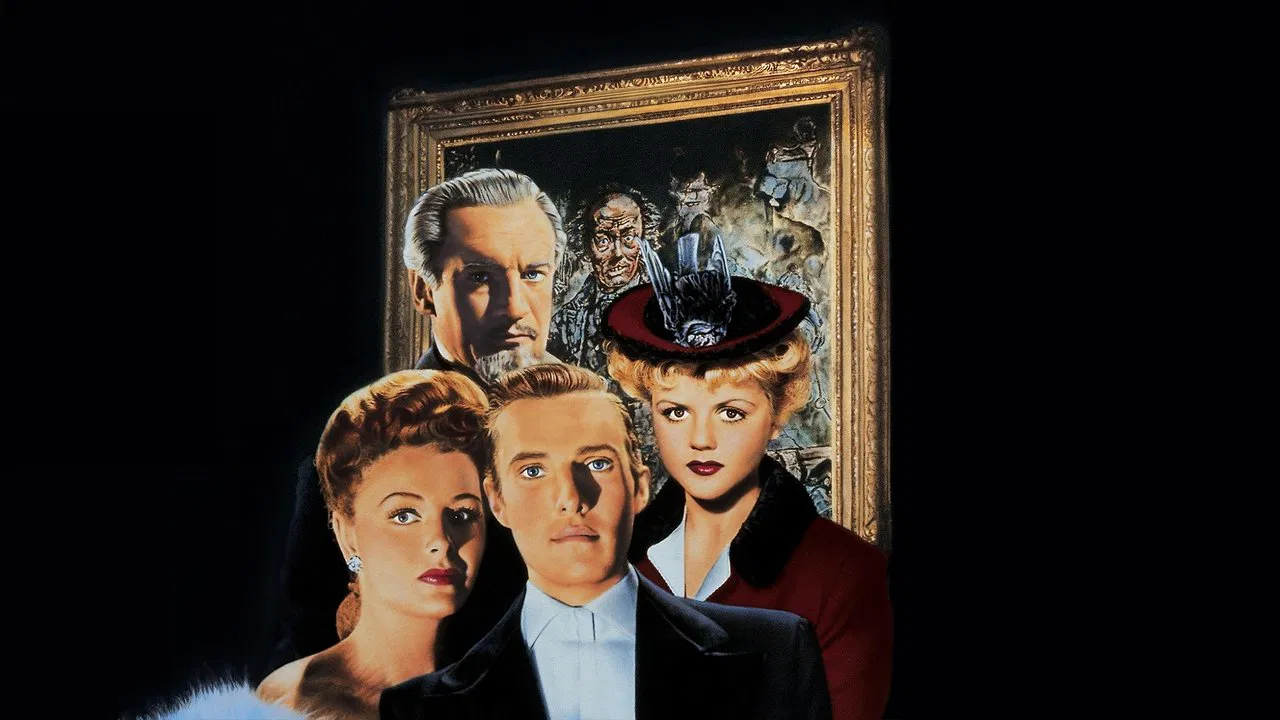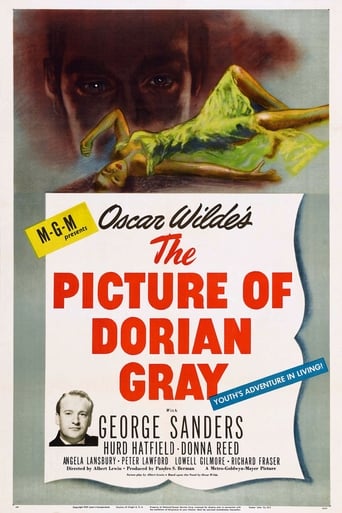

It was hard to hear people talking in the movie and the ending was not all that great. The ending was when the main character kicked the picture and did not have the curse anymore he did not even know that would work he was just mad and kicking the picture.
... View MoreTHE PICTURE OF DORIAN GRAY (1945) A Review by JP July 20, 2016"Each of us has Heaven & Hell in him." –Oscar Wilde Youth. Pride. Vanity. Morality. Mortality.Each & Every moment spoken in this dark, macabre cautionary tale is quote-worthy, thought-provoking, and piercingly-existential. Adapted from playwright Oscar Wilde's only novel & reminiscent of "The Monkey's Paw", "The Picture of Dorian Gray" weaves the wicked web of a young man inspired to sell his soul to never grow old upon viewing a portrait painted of himself which perfectly-captured the innocence & beauty of his youth. The cliché "be careful what you wish for" would be an understatement in this story, which still holds significance today as we are still a vain, self-damning species.Hurd Hatfield (El Cid, King of Kings) plays Dorian Gray with steely eyes and a level of intensity comparable to Anthony Perkins in "Psycho" (1960). Narrated by the great George Sanders (Rebecca, All About Eve), as Wilde's counterpart Lord Henry Wooten, the pivotal supporting role inadvertently-responsible for the title character's ill-fated decision & subsequent downward spiral – brings a witty cynicism to the bleak, shadowy gloom despite his old-fashioned chauvinistic ways. A cherubic Angela Landsbury (Bedknobs & Broomsticks, Murder, She Wrote), archetypal golden era maiden Donna Reed (It's a Wonderful Life, From Here to Eternity), and, surprisingly-non-Rat Pack Peter Lawford (Ocean's 11, Exodus) add style & grace to this elegantly-crafted, Oscar-winning hidden gem which deserves much more than a mere Warner Archive release (Hint, Hint Criterion).A notable aspect, which I'm sure was quite a feat at the time, was the decision to have the film in black & white with the exception of the portrait twice, once for the initial reveal & last for the most hideous deterioration."Was it true that one could never change? He longed for the unstained purity of his youth, before he had prayed in a monstrous moment of pride & passion that the painting should bear the burden of the years & of his corruptions." – Oscar Wilde
... View MoreA corrupt young man (Hurd Hatfield) somehow keeps his youthful beauty, but a special painting gradually reveals his inner ugliness to all.As with all classic literature, numerous version of the Dorian Gray story exist. And also like classic literature, the best versions seem to have arrived early on. Much like David Lean's versions of Dickens, this 1945 version of Dorian Gray could probably never be equaled. It just has the look about it that only films of the day could have.Quite interestingly, the lead is played by Hurd Hatfield, whom I had never heard of before. One of the stars is Angela Lansbury, who in hindsight is probably the biggest name associated with the film. We are blessed that she offered her thoughts to an audio commentary.
... View MoreBased on the novel by Oscar Wilde, "The Picture of Dorian Gray" tells the story of a handsome young man corrupted by the opinions of an eloquent elderly gentleman (brilliantly played by George Sanders), who induces the former into seeking only pleasure in life. To achieve this purpose, the young man sells his soul through some sort of black magic, in order to remain youthful his whole life. Contrarily to his face as seen by the aging people around him, Dorian's hidden painted picture instead becomes rotten, dreadful and horrid, changing every time his soul descends more and more into darkness. The source of his misery is never revealed, but some crimes on the way are. Eventually, Dorian becomes sick of his world of lies and deceit, and stabs his portrait, actually stabbing his own chest, later being found dead and disfigured by the evilness of his deeds.Classic books are extremely hard to adapt into movies or television series. Filmmakers must thus avoid many common mistakes. One of the major mistakes is reducing the complexity of the plot. That is not the case of this film, whose screenplay could wittily uphold the lyricism of the book. There are some wonderful dialogs, where the style of Oscar Wilde was preserved, showing the audience how literature and movies share similar possibilities of artistic expressions.Oscar Wilde is one of the few writers who enjoy a well-deserved reputation for mastering the art of putting into words the misery of the soul. Deprived from the personal freedom required to develop even the most recondite corner of his spirit, the Englishwriter suffered from the moralism that pervaded in Britain during the Victorian era. Of course, a modern reader should not replicate at that time the contemporary way of approaching morals. The evolution of social values and behavioral patterns is a complex and long-lasting process. Sexual tolerance, for instance, could only be achieved in the Western world after a pile of many other prejudices was demolished, and occasionally demanded bloodshed of those who later became martyrs of the cause.Literature, however, does not consist of simply writing about themes the author cherishes himself. It also comprises the technique, that is, the method of exposing a particular point of view. Wilde had definitely a sensitive soul, which he managed to translate into beautifully accomplished passages of the book. The story of Dorian Gray–obviously one of Wilde's alter egos–has a relatively linear plot. In spite of that, literary historians still dispute, amid bafflement, over the reasons underlying the enormous success of the book when it was first published.According to the most supported stance, in addition to the controversy over the background theme of the book, Wilde's masterpiece reached stardom for its prose displays an incredible lyricism–a trait more usually found in poetry. Since it was written in form of prose, this lyricism emerges most sharply from the metaphors chosen to express the dramatic situation of Mr. Gray and the symbolism of objects surrounding the characters: the picture itself, obscure poems, and the sculpture of a cat, along with other artistic pieces–the latter were imported from the overseas colonies as elements of orientalism, some sort of philosophy that became a trend during the age of imperial England.Although it was to the knowledge of everybody, the theme of homosexuality remains implied both in the book and in the film. On the one hand, the audience is offered just hints of what secrets Dorian Gray might have with other characters–clearly lovers in disguise. On the other hand, since the subject is not overtly discussed, readers and viewers may find Dorian's reaction to the moralism of his society dubious. Thus, the story sends us mixed messages about his thesis: either homosexuality, as correctly condemned by society and religion, is something spurious and shameful, no wonder why it is the doorway that leads our character into committing atrocities–such as homicide and blackmail; or moral judgment of society is solely responsible for the isolation and transformation of Dorian(and his picture) into a monster, and not his feelings and inclinations.
... View More